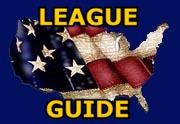BUCK MILLER III
Buck Miller III – Modern Draft League Manager
(1) Miller III does NOT save a rotation; you MUST bench your starters to prevent their use in relief. Miller III will use any pitcher that is not benched regardless of their grade, rating or stats (e.g., any relief appearances).
(2) Miller III (like versions I, II and IV) is NOT designed for historic or season replays. They are designed solely for draft league games. Use of the Miller managers in a historic season will lead to odd results or stats.
Buck Miller III is designed to handle modern draft league only replays. He is not designed to manage season replays of any type. Although created to guide modern seasons, he may be adequate in handling pre-modern (e.g, 1990) replays depending on your team’s roster.
Several important points to make:
1) Miller III, as noted above, does NOT set aside a starting rotation. He will and does use any pitcher not specifically benched in League Manager or in your lineup/rotation setup. So, you MUST bench your rotation (or choose the “Bench Pitching Rotation” option in LM).
2) Miller III selects closers by saves and not grades. A reliever, for example, with high save totals but low grade will be used over a relievers with high grades but few saves. A “normal” closer will have more than 12 saves. A “supercloser” will have saves of 20+. Miller III will, obviously, more aggressively use the superclosers than the “normal” closers. Teams with multiple closers will see the closer with highest save totals being selected as the primary closer and the other closers likely used as setup relievers. However, Miller III will have a quick hook with one “struggling” closer in favor of the secondary (or tertiary, et cetera) closers.
3) Generally, Miller III follows the LaRussa one inning closer approach. That is, closers (both normal and super) will likely only pitch the ninth in save situations. Set up relievers will be heavily used before then. If a team has more than one closer, as noted above, the lower save closer will be used as a setup reliever for the superior closer.
4) Miller III (like I, II and IV) hates to see relievers hit. You’ll see a very aggressive use of double switches and “rearrangement” of the batting order to try and limit the times a reliever hits. Generally, unless the reliever is a “stud” pitcher or the game is lopsided or a team’s bullpen is thin due to overwork, you’ll likely never see a relief pitcher hit.
5) In addition to point (4) above, Miller III (and the other manages) tends to “rotate” or use multiple relievers in games. Except very early in games (or where a team’s bullpen is thin), you’ll likely see Miller use 3-4 relievers over the course of a game – even in non-close games – where a reliever may pitch only one inning, two at most.
Note: One strong suggestion re this is to have, if possible, at least one long reliever (QR of 2 or 1) on your roster. It’s advisable to have one reliever who can pitch 2-4 innings in an emergency (e.g., starter gets hurt or ejected in the first or second inning). If you stock you team with quality but high QR relievers (relieving durability of 3) and no long reliever, you’ll likely see Miller using one of the short role relievers for 3-4 innings which will make him basically unusable for 4-5 days until he recovers his RR.
6) Miller III has a number of “bells and whistles” some of which may or may not be applicable to your team. For example, he has several pinchrun to steal strategies (second or third) that may not apply to your team if you don’t have a good base stealer on your bench (e.g., steal rating of 28 or higher). Additionally, Miller III has a pinch hit to bunt strategy that requires a “good bunter” be available; a pinch hit for a hit and run situation (that also requires a bench hitter with a good H&R ability that includes a low SO/AB ratio) and a few other assortment bells.







